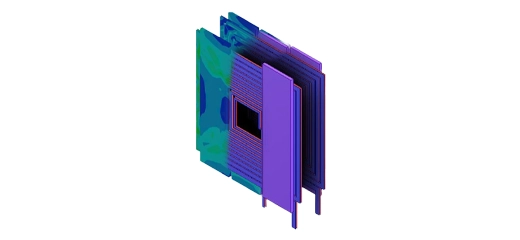Magnetic Coupling Machine
Magnetic coupling systems allow torque transmission from a primary driver to a follower/load without any mechanical contact. As the torque could be transmitted across a separation wall, contactless magnetic couplings are well suited for use in isolated systems.
Compared to mechanical couplings, magnetic couplings present many advantages such as protection against overloads, reduced maintenance, and a high tolerance to misalignment between the prime mover and the load.
There are several types of magnetic coupling such as synchronous, eddy current, and reluctance couplers with axial or radial flux directions.

Radial and Axial Flux Synchronous Coupling Machine Types
In the synchronous coupler type, both the drive and the load side of the coupler rotate synchronously, and the poles are paired simultaneously. The torque production results from the magnetic field interaction in the air gap separating the two sides. Hence, the torque applied to one disk is transferred through this air gap to the other disk.
Permanent Magnet Arrangement in a Coupling Machine
Radial Flux Coaxial Permanent Magnet Coupling
The first synchronous coupling machine design was made of two coaxial inner and outer back iron rings mounted with radially magnetized permanent magnets. Coaxial couplers are generally characterized by the rotation of the inner driver inside the outer follower. This type of coupling is used to produce a larger transmitted torque independent of speed and dependent only on the relative displacement angle of the coupler halves.
The three different configurations were studied to investigate the effect of the number of poles on the coupling performance.
The magnetic flux animation plots below illustrate the movement of one rotor and their magnetic field reaction imposed onto the other rotor or load side rotor.
Magnetic Flux Density Animations for 8, 12 & 24 Pole Coupling Designs
The static analysis was conducted to obtain the rotating torque waveform for rotors with different coupling configurations. It was observed that, as the number of poles per rotor increases, the torque magnitude and the frequency of the torque also increase. The general behavior of the torque variation versus the number of poles is defined in the second plot showing a great proportionality between the two parameters.
Static Torque Plots for 8, 12 & 24 Poles Coupling Designs
Torque Variation versus the Number of Rotor Poles
Another analysis of magnetic losses in the permanent magnets was performed for three different coupling designs, which helped compute the amount of ohmic losses due to the magnet's electric resistivity. We found a non-proportional relation between the number of poles and the generated power loss, which was less significant in the case of 24 24-pole coupling machines with an average value of 160W compared to 400W for the first configuration.
The second animation plot shows the distribution of the solid losses across the permanent magnet.
Magnetic Loss Curves for 8, 12 & 24 Poles Coupling Designs
Animation of the Solid Loss Density for the 12 Poles Coupling Design
Axial Flux Permanent Magnet Coupling
In this section, the coupling design is axial flux type which consists of two opposing identical discs or rotors made from soft iron yokes, equipped with rare earth permanent magnets magnetized in an axial direction and arranged to obtain north and south poles. When applying torque to the load side of the disc, the two discs shift by an angle, which is known as the load angle. In this design, the angular shift between the two discs depends on the initial torque applied. One of the major drawbacks of this design is the significant amount of attractive force acting between the two rotors.
The figure below presents the vector distribution of the magnetic flux around the coupling and its axial behavior in the air gap separating the discs.
Vector Distribution of the Magnetic Flux Density
By varying the rotating angle between the magnetized poles of the rotors, the solver computes the electromagnetic static torque at each scenario for a fixed air gap value of 9.5 mm. The maximum static torque is attained for a load angle of 15° as shown below. When the polarized poles are completely aligned, the magnetic reluctance is minimum which leads to a minimum torque. While at 15°, the magnetic reluctance is at its peak value. Therefore, the magnetic torque reaches its maximum magnitude at this position.
Pull-out Torque and Magnetic Flux Density Variation with Air Gap Distance in Axial Flux Coupling Machine
Another essential parameter that affects the performance of the axial flux coupling machines, is the air gap distance between the driver and load rotors. A parametric analysis of the air gap distance for a fixed load angle of 15°, allowed us to obtain the following findings.
The pull-out torque of the studied magnetic coupling decreases quickly as the distance between the magnets increases. The maximum torque is almost divided by two when the air gap passes from 2mm to 7 mm, which is very significant in our case.
The magnetic flux density animation shows the effect of air gap variation on the magnetic field intensity which is maximum for a small distance.
Pull-out Torque and Magnetic Flux Density Variation with Air Gap Distance in Axial Flux Coupling Machine
For a fixed air gap distance of 9.5 mm and a constant angular speed of 500 rpm (3000 deg/s) applied to the mover rotor and while fixing the second rotor; the Motion study in EMS allows to compute the generated torque and angular displacement of the driver rotor versus time. The computed oscillating torque achieves a maximum value of 25 N.m for both rotors.
Static Torque Curves for Driver and Load Rotors at 500 rpm
Animation of the Magnetic Flux Density at 500 rpm
The use of permanent magnets in magnetic couplers is a promising technique for applications requiring isolation between two different atmospheres without the need for mechanical contact between the rotating parts. An accurate knowledge of the magnetic field distributions for different geometrical configurations is necessary for predicting the torque and speed behaviour of such mechanical equipment.
References
1. Bastien Dolisy, Thierry Lubin, Smail Mezani, Jean Lévêque. Three-Dimensional Analytical Model for an Axial-Field Magnetic Coupling. Progress In Electromagnetics Research M, 2014, 35, pp.173-182. 10.2528/PIERM14031405 . hal-01011497
2. Akcay, Yusuf, et al. "Fast and accurate 2d analytical subdomain method for coaxial magnetic coupling analysis." Energies 14.15 (2021): 4656.



